Abstract
Ambulatory electrocardiography was carried out in 21 healthy, fit, male squash players (aged 23-43 years) before, during, and after match play. Resulting electrocardiograms were analysed with respect to heart rate and changes in rhythm. The results indicate that squash increases the heart rate to 80% of an individual's predicted maximum heart rate for the duration of a game. Ventricular arrhythmias were detected in seven of the subjects during play and in seven in the immediate post-exercise period, an incidence which was not reproduced on subsequent maximal treadmill exercise testing. This study indicates that squash is a physiologically demanding sport which places a severe strain on the myocardium for considerable periods of time and is capable of generating cardiac arrhythmias. These findings are particularly important for an individual already at risk of sudden death from coronary artery disease or structural cardiovascular abnormalities. Medical advice before participation in the game will identify those at high risk of cardiovascular disease. Subjects in this study who developed arrhythmias were not, however, identified by history, examination, or exercise electrocardiography. Thus, it seems unwise to begin playing squash after the age of 40 years. Whether subjects in this age group already participating in the game should continue to play remains a matter for individual judgment.
Full text
PDF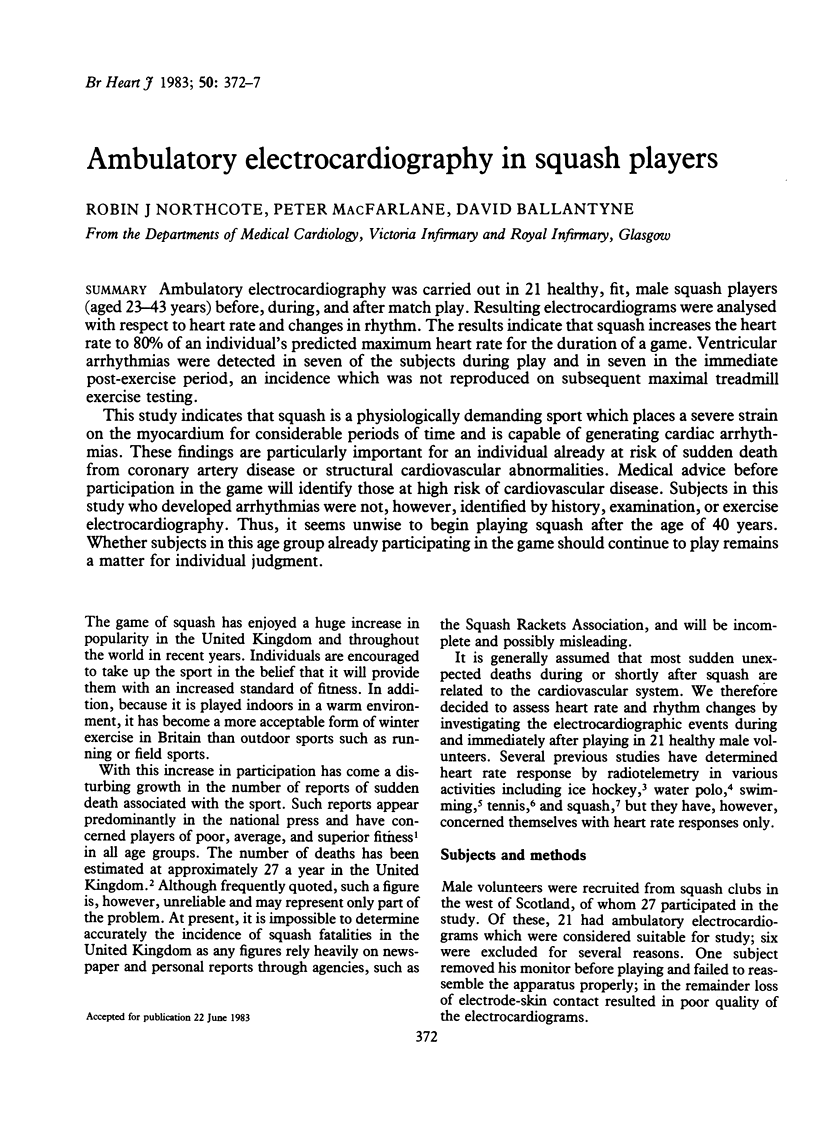
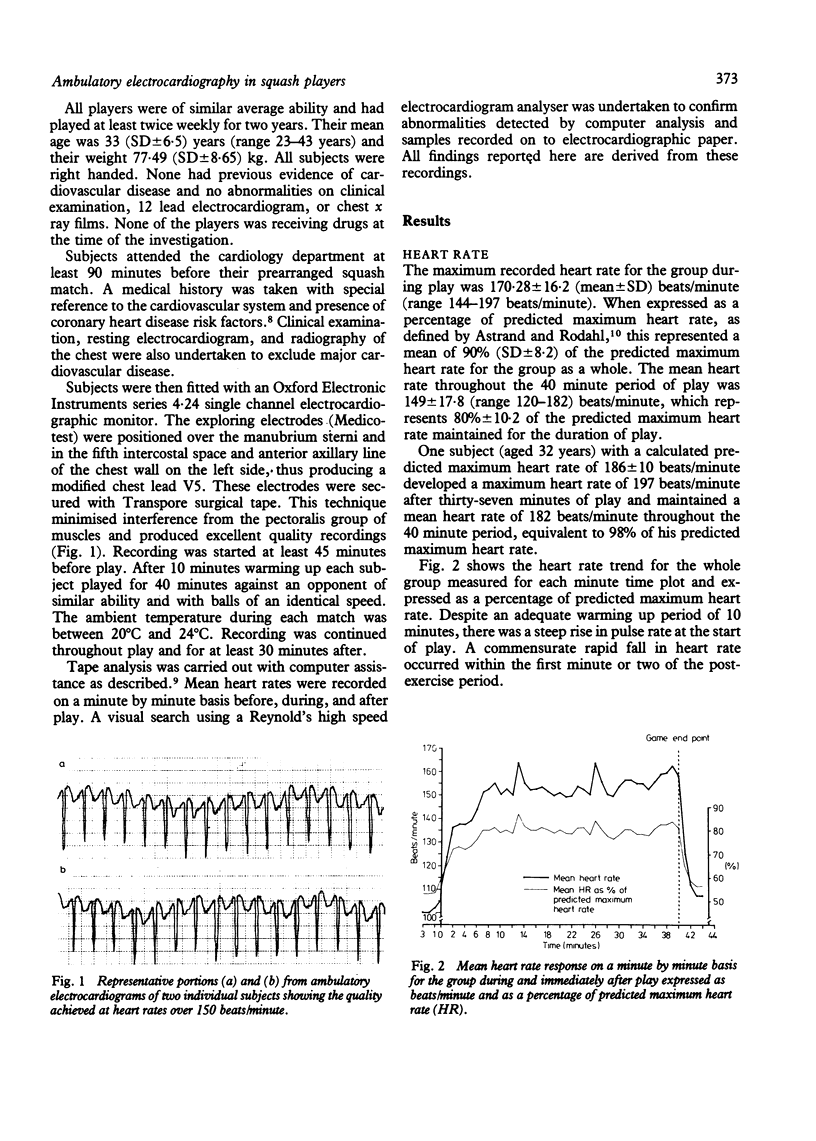
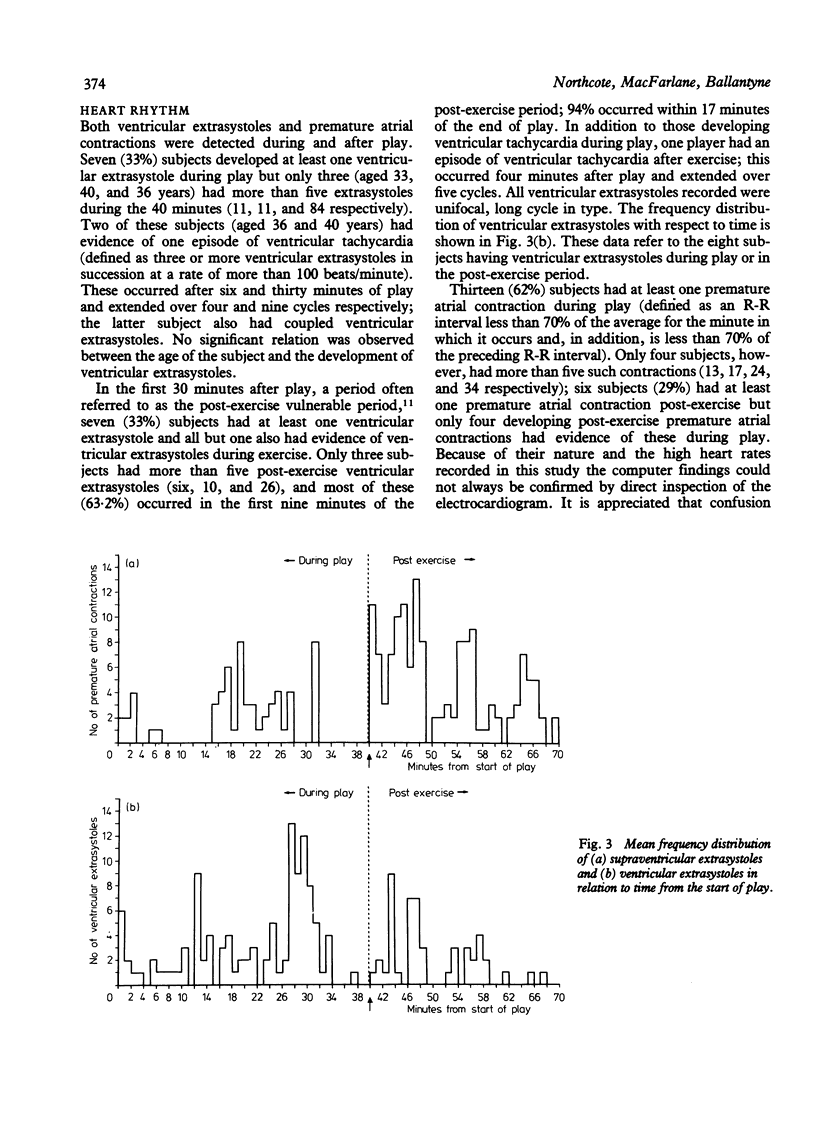
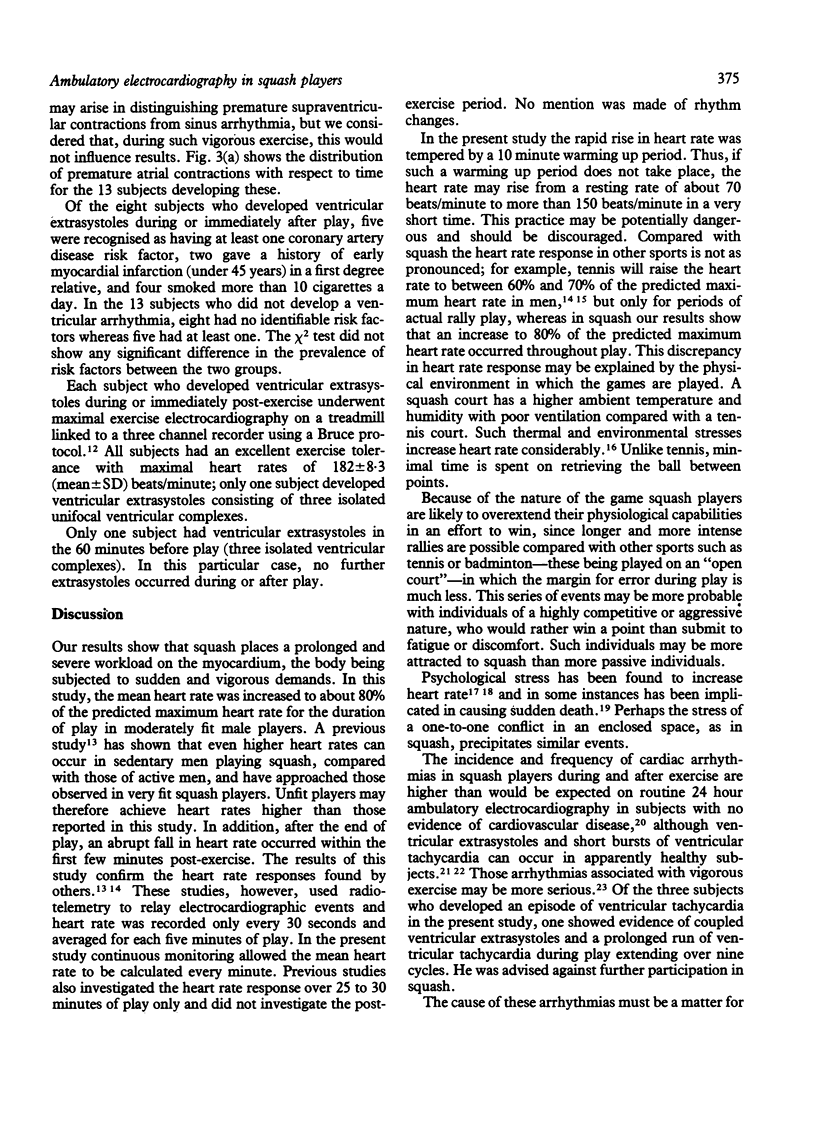
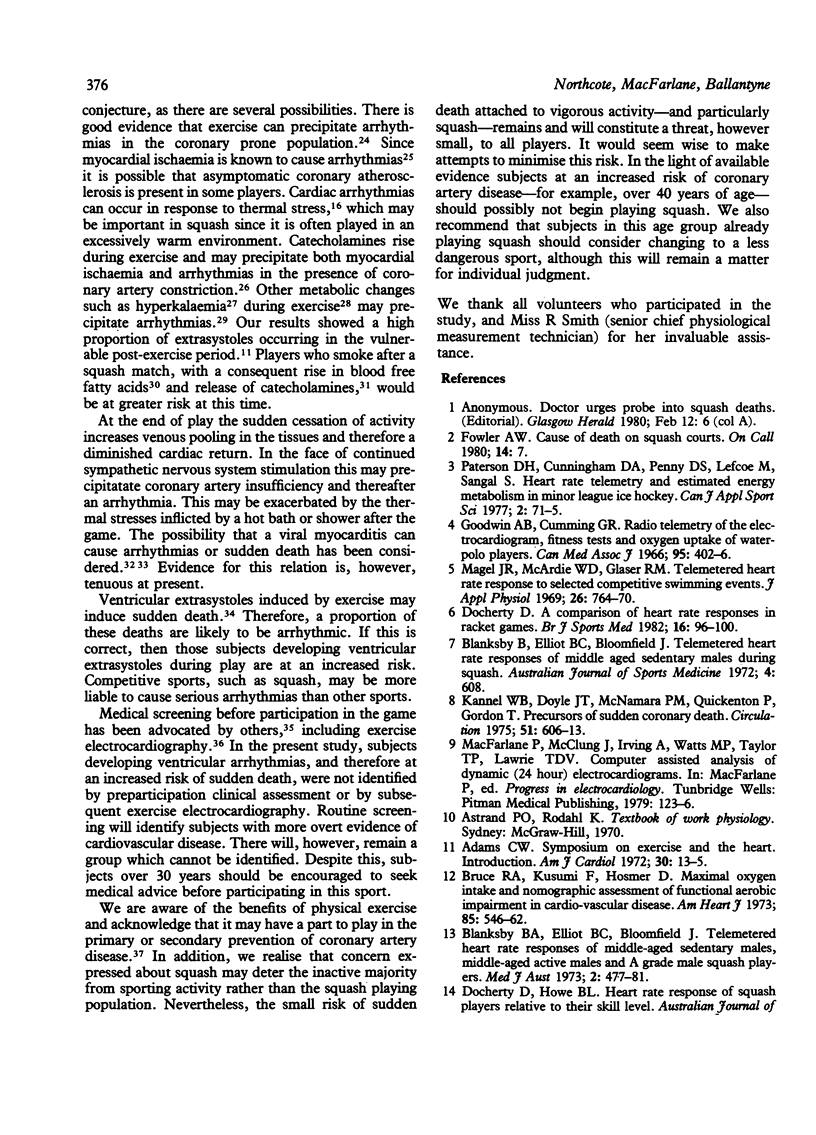
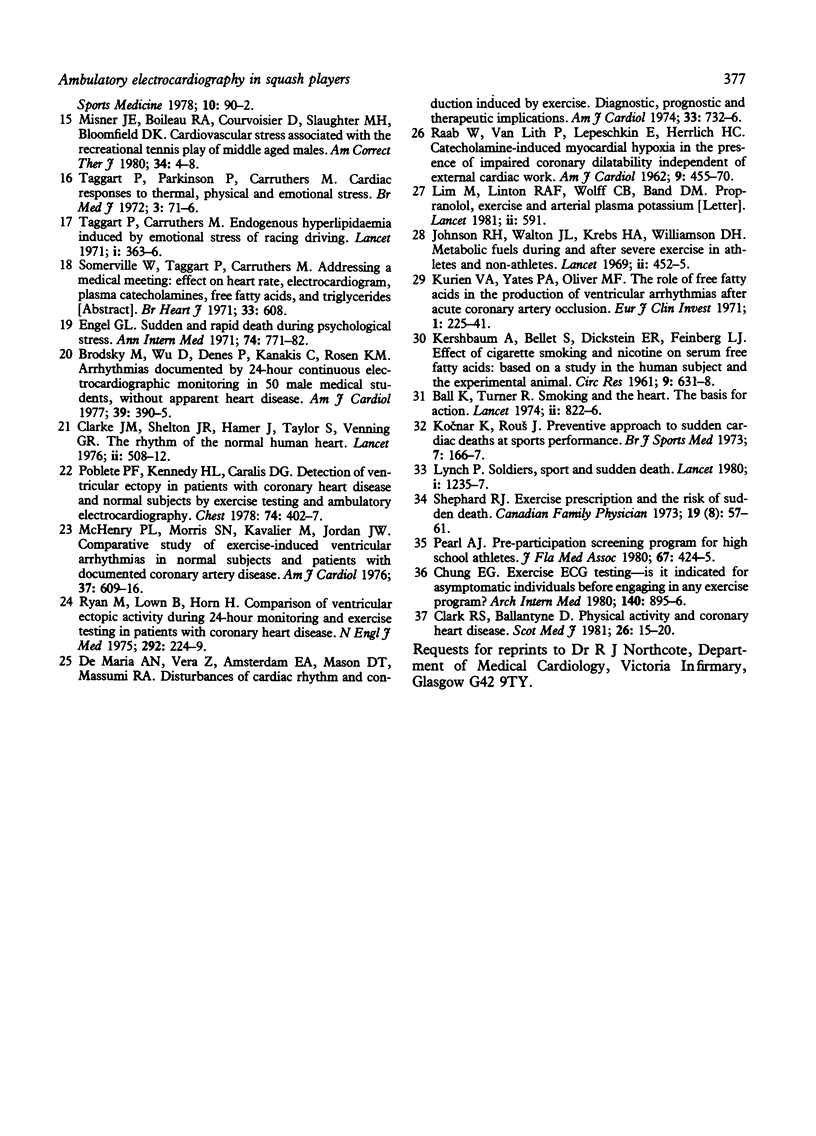
Selected References
These references are in PubMed. This may not be the complete list of references from this article.
- Ball K., Turner R. Smoking and the heart. The basis for action. Lancet. 1974 Oct 5;2(7884):822–826. doi: 10.1016/s0140-6736(74)91083-6. [DOI] [PubMed] [Google Scholar]
- Blanksby B. A., Elliott B. C., Bloomfield J. Telemetered heart rate responses of middle-aged sedentary males, middle-aged active males and "a" grade male squash players. Med J Aust. 1973 Sep 8;2(10):477–481. doi: 10.5694/j.1326-5377.1973.tb128870.x. [DOI] [PubMed] [Google Scholar]
- Brodsky M., Wu D., Denes P., Kanakis C., Rosen K. M. Arrhythmias documented by 24 hour continuous electrocardiographic monitoring in 50 male medical students without apparent heart disease. Am J Cardiol. 1977 Mar;39(3):390–395. doi: 10.1016/s0002-9149(77)80094-5. [DOI] [PubMed] [Google Scholar]
- Bruce R. A., Kusumi F., Hosmer D. Maximal oxygen intake and nomographic assessment of functional aerobic impairment in cardiovascular disease. Am Heart J. 1973 Apr;85(4):546–562. doi: 10.1016/0002-8703(73)90502-4. [DOI] [PubMed] [Google Scholar]
- Chung E. K. Exercise ECG testing. Is it indicated for asymptomatic individuals before engaging in any exercise program? Arch Intern Med. 1980 Jul;140(7):895–896. doi: 10.1001/archinte.140.7.895. [DOI] [PubMed] [Google Scholar]
- Clark R. S., Ballantyne D. Physical activity and coronary heart disease. Scott Med J. 1981 Jan;26(1):15–20. doi: 10.1177/003693308102600105. [DOI] [PubMed] [Google Scholar]
- Clarke J. M., Hamer J., Shelton J. R., Taylor S., Venning G. R. The rhythm of the normal human heart. Lancet. 1976 Sep 4;1(7984):508–512. doi: 10.1016/s0140-6736(76)90801-1. [DOI] [PubMed] [Google Scholar]
- DeMaria A. N., Vera Z., Amsterdam E. A., Mason D. T., Massumi R. A. Disturbances of cardiac rhythm and conduction induced by exercise. Diagnostic, prognostic and therapeutic implications. Am J Cardiol. 1974 May 20;33(6):732–736. doi: 10.1016/0002-9149(74)90213-6. [DOI] [PubMed] [Google Scholar]
- Docherty D. A comparison of heart rate responses in racquet games. Br J Sports Med. 1982 Jun;16(2):96–100. doi: 10.1136/bjsm.16.2.96. [DOI] [PMC free article] [PubMed] [Google Scholar]
- Engel G. L. Sudden and rapid death during psychological stress. Folklore or folk wisdom? Ann Intern Med. 1971 May;74(5):771–782. doi: 10.7326/0003-4819-74-5-771. [DOI] [PubMed] [Google Scholar]
- Goodwin A. B., Cumming G. R. Radio telemetry of the electrocardiogram, fitness tests, and oxygen uptake of water-polo players. Can Med Assoc J. 1966 Aug 27;95(9):402–406. [PMC free article] [PubMed] [Google Scholar]
- Johnson R. H., Walton J. L., Krebs H. A., Williamson D. H. Metabolic fuels during and after severe exercise in athletes and non-athletes. Lancet. 1969 Aug 30;2(7618):452–455. doi: 10.1016/s0140-6736(69)90164-0. [DOI] [PubMed] [Google Scholar]
- KERSHBAUM A., BELLET S., DICKSTEIN E. R., FEINBERGL J. Effect of cigarette smoking and nicotine on serum free fatty acids based on a study in the human subject and the experimental animal. Circ Res. 1961 May;9:631–638. doi: 10.1161/01.res.9.3.631. [DOI] [PubMed] [Google Scholar]
- Kannel W. B., Doyle J. T., McNamara P. M., Quickenton P., Gordon T. Precursors of sudden coronary death. Factors related to the incidence of sudden death. Circulation. 1975 Apr;51(4):606–613. doi: 10.1161/01.cir.51.4.606. [DOI] [PubMed] [Google Scholar]
- Kurien V. A., Yates P. A., Oliver M. F. The role of free fatty acids in the production of ventricular arrhythmias after acute coronary artery occlusion. Eur J Clin Invest. 1971 Jan;1(4):225–241. doi: 10.1111/eci.1971.1.4.225. [DOI] [PubMed] [Google Scholar]
- Lim M., Linton R. A., Wolff C. B., Band D. M. Propranolol, exercise, and arterial plasma potassium. Lancet. 1981 Sep 12;2(8246):591–591. doi: 10.1016/s0140-6736(81)90987-9. [DOI] [PubMed] [Google Scholar]
- Lynch P. Soldiers, sport, and sudden death. Lancet. 1980 Jun 7;1(8180):1235–1237. doi: 10.1016/s0140-6736(80)91691-8. [DOI] [PubMed] [Google Scholar]
- McHenry P. L., Morris S. N., Kavalier M., Jordan J. W. Comparative study of exercise-induced ventricular arrhythmias in normal subjects and patients with documented coronary artery disease. Am J Cardiol. 1976 Mar 31;37(4):609–616. doi: 10.1016/0002-9149(76)90403-3. [DOI] [PubMed] [Google Scholar]
- Pearl A. J. Preparticipation screening program for high school athletes. J Fla Med Assoc. 1980 Apr;67(4):424–425. [PubMed] [Google Scholar]
- Poblete P. F., Kennedy H. L., Caralis D. G. Detection of ventricular ectopy in patients with coronary heart disease and normal subjects by exercise testing and ambulatory electrocardiography. Chest. 1978 Oct;74(4):402–407. doi: 10.1378/chest.74.4.402. [DOI] [PubMed] [Google Scholar]
- RAAB W., VAN LITH P., LEPESCHKIN E., HERRLICH H. C. Catecholamine-induced myocardial hypoxia in the presence of impaired coronary dilatability independent of external cardiac work. Am J Cardiol. 1962 Mar;9:455–470. doi: 10.1016/0002-9149(62)90163-7. [DOI] [PubMed] [Google Scholar]
- Ryan M., Lown B., Horn H. Comparison of ventricular ectopic activity during 24-hour monitoring and exercise testing in patients with coronary heart disease. N Engl J Med. 1975 Jan 30;292(5):224–229. doi: 10.1056/NEJM197501302920502. [DOI] [PubMed] [Google Scholar]
- Somerville W., Taggart P., Carruthers M. Addressing a medical meeting: effect on heart rate, electrocardiogram, plasma catecholamines, free fatty acids, and triglycerides. Br Heart J. 1971 Jul;33(4):608–608. [PMC free article] [PubMed] [Google Scholar]
- Taggart P., Carruthers M. Endogenous hyperlipidaemia induced by emotional stress of racing driving. Lancet. 1971 Feb 20;1(7695):363–366. doi: 10.1016/s0140-6736(71)92207-0. [DOI] [PubMed] [Google Scholar]
- Taggart P., Parkinson P., Carruthers M. Cardiac responses to thermal, physical, and emotional stress. Br Med J. 1972 Jul 8;3(5818):71–76. doi: 10.1136/bmj.3.5818.71. [DOI] [PMC free article] [PubMed] [Google Scholar]


